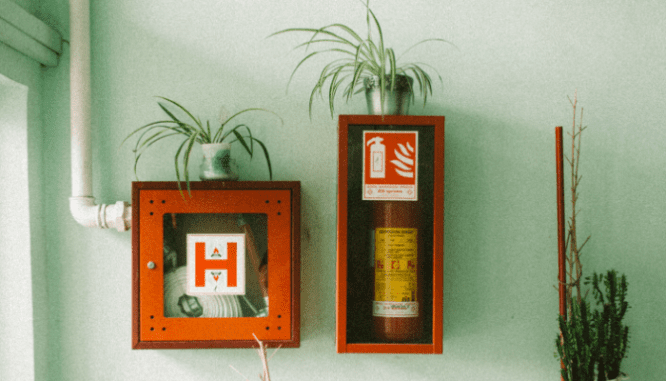It’s Yours! 27 Ways to Turn Your New House Into A Home
- Published on
- 7 min read
-
 Melissa Holtje Contributing AuthorClose
Melissa Holtje Contributing AuthorClose Melissa Holtje Contributing Author
Melissa Holtje Contributing AuthorMelissa enjoys using her experience as a house flipper, investment buyer, and waterfront home owner to help buyers and sellers thrive in the housing market. When not scouting real estate, you’ll most likely find her at the beach.
Purchasing a new house is one thing, but turning it into a home is another. Anyone can simply live in a new place. But thriving in a new home is the goal.
With the help of Patricia Richmond-Young, a top real estate agent and Accredited Buyer Representative in Memphis, Tennessee, we’ve compiled this list of 27 tips for getting settled in your new home. From safety checks to housewarming parties, we’ve got your first few weeks of homeownership covered. Consider this your home-making how-to guide!

Set yourself up to cook and eat
According to the old adage, the kitchen is the heart of the home. If that’s true, then prioritize your home’s “heart” by getting to work on those boxes as soon as you can.
Richmond-Young tells her clients to make the kitchen a top priority from day one. “Even if you’re ordering out, you still need to be able to function in the kitchen now,” she says. “So you want to unpack the kitchen first.”
Nothing makes a house feel like home faster than eating a meal together. Unpacking dishes, utensils, pots, and small appliances (hello, coffeemaker!) allows for that sense of normalcy to return.
Actually, the kitchen may be a great place to enlist the help of a friend, if possible. Simply use a sticky note to label what you’d like to see in each cabinet and drawer, then set them to work! Keep the labels in place for a few days as you get used to cooking and eating in your new kitchen.
Clean before you unpack
But before you start filling up your closets and cabinets, be sure to give them a good cleaning. Dirt and dust tend to gather in the corner of shelves, and now’s the best time to get rid of it. You may also want to rent a carpet cleaner before setting up your furniture to get rid of any hidden dirt and start with a clean slate.
Don’t forget to clean inside your appliances, which can harbor dangerous germs. In a study done by NSF International, refrigerator drawers were one of the most common places to find bacteria such as E. coli, listeria, and salmonella.
To speed up the process, consider hiring a professional cleaner who specializes in deep cleaning for move-ins. Once the cleaner is done with one room, you can focus on unpacking there.
Arrange your furniture
To make your new place feel most home-like at first, you may want to set it up the same way you had it (more or less) in your previous home. If that’s not possible, check the listing photos.
If the home was staged or furnished when the photos were taken, then you could try to recreate that setup using your own pieces. Remember — nothing is permanent. It’s okay to rearrange your furniture over the next few months as you live in the space.

Change your address
Stop by the local post office or fill out this online form to change your official address and have mail forwarded from your previous residence. To go one step further, you’ll also need to inform credit companies, banks, cell phone carriers, charities, and magazines. You may want to update your favorite shopping catalogues, too!
As far as your friends and family are concerned, a digital notification usually does the trick in terms of getting your new address into their hands. Try making a fun, free e-card using Paperless Post and sending it out via email.
File your paperwork
Don’t let your important paperwork get lost in the moving shuffle! Take some time to organize your closing documents, insurance policies, warranties, receipts, and tax papers.
We like these filing bins because of their sturdy construction and clear sides. You may also want to invest in a fire safe for your deeds, titles, and identification papers.
Transfer your utilities and services
Hopefully, you were able to coordinate the transfer of electricity and water prior to moving, but if not, those will need to be a top priority. Make sure to set up phone, internet, security, and television services as well — without those, it’s hard for a house to feel like home!
In addition, think through specific services that you may need in your new home. Will you require a regular lawn service, cleaning service, or pool service? Your real estate agent can give you a referral, or they can ask the previous owners for a recommendation.

Change your locks
Even though you should have gotten all the keys at closing, the previous owners may have forgotten about keys given out to family members or friends. To be safe, it’s best to have all the exterior locks changed on your new home. Hiring a locksmith to replace or rekey all the locks will run you around $75 per hour, plus the cost of parts. However, you can also do it yourself by watching a tutorial like this one.
Change the garage door remotes and codes
If your new home has a garage, it’s a good idea to reprogram the remotes and keypads to ensure that the entry point stays secure. The previous owners may have left you a manual to do this easily. Otherwise, look up the manufacturer’s guide online, or consult a general step-by-step guide, such as this one.
Check smoke detectors
Check that all smoke detectors in your new home are in good working order. Change the batteries so that you can start fresh in your maintenance cycle. Be sure that no smoke detectors have been painted over, as well.
In addition, check for proper smoke detector placement. The National Fire Protection Association recommends that smoke alarms be placed inside each bedroom, outside sleeping areas, and on each level of the home, including basements. Smoke alarms in cooking areas should be placed ten feet away from appliances to minimize false alarms. And be sure that smoke detectors are located away from windows and doors where a draft may decrease their effectiveness.
Check carbon monoxide detectors
At the same time, check for the existence and functioning of carbon monoxide detectors. At minimum, CO detectors should be installed on each floor and in attached garages. But because carbon monoxide is invisible and odorless, installing one in each bedroom is recommended.
In contrast to smoke detectors, which should be positioned on or near the ceiling, CO detectors should be installed at knee-height.

Settle the kids
A move can be both exciting and unsettling for children. Do your best to make the move a positive experience for kids by focusing on their spaces first. If you’re planning to update the paint in their rooms, make that the first project on your list, so that they don’t have to wait long to settle in.
Ask for their opinions about color choices and furniture placement. And be sure to involve them in the unpacking process so that they know where all their favorite clothing and toys are located.
Settle the pets
Pets may experience anxiety when moved to a new home. Help them get used to their new environment by setting up their area immediately.
To maintain a familiar smell, don’t wash their bedding or toys for a few weeks. Do your best to stay on a consistent schedule, and try to stay home as much as you can to help them feel safe and secure in their new home.
Familiarize yourself with your home’s circuit box
Don’t wait for a power outage to look over the switches in your circuit box. (If you are having trouble locating your circuit box, consult the inspection report. There should be a photo to guide you.)
With the help of another family member, test each circuit to make sure each one is clearly and correctly labeled. If necessary, you can call each other on your cell phones as you’re working your way down the circuit board.
Locate the water and gas shutoffs
Similarly, Richmond-Young says you’ll want to find your main water shutoff and gas shutoff now — before an emergency arises. Your home inspector should have tested the gas main and water main functionality, but feel free to do your own test now that you’ve moved in.
Also, take note of localized toilet, sink, oven, furnace, and refrigerator water shutoffs so that you’re prepared should a problem arise.

Find the fire extinguisher (or buy one)
Every home should have at least one fire extinguisher, and preferably at least one fire extinguisher per floor. According to a report by the NFPA, cooking fires account for 49% of all home fires in the United States. To be proactive about this danger, be sure that you have at least one fire extinguisher in the kitchen of your new home.
Other good locations for fire extinguishers include garages, basements, outdoor kitchens, bathrooms, and any other place where a heat source may ignite a fire.
Obtain window treatments
Window treatments are more than just a cosmetic nicety. Blinds and curtains increase privacy and help you get a good night’s sleep — important elements in making a house into a home.
In some areas of the country, it’s common for blinds and curtains to transfer with a property, while in other areas, owners take those items with them. Either way, make window treatments a priority when settling into your new home.
Get on Google Maps
Browsing Google Maps can help you get a bird’s-eye view of your new home’s surrounding area.
Check out what restaurants are close by. Pinpoint the closest hospital. Check the routes and drive times to your workplace, school, and/or place of worship. Make note of veterinarians, car mechanics, doctors, and dentists before you actually need them. And locate nearby entertainment options, including parks, libraries, zoos, theaters, shopping centers, and bars.
Walk, bike, or drive around
The internet is great, but you also need to physically acclimate yourself to your new surroundings.
Take a stroll around your new neighborhood. What markets, services, bus stops, parks, and trails are within walking distance? Can you find on-foot shortcuts to some of your favorite local cafes or shops? Is there a playground or market within biking distance?
Hop in your car to broaden your range and get familiar with the streets. As you circle outward, are there new local eateries you’d like to try? Are there places to pick up a new hobby or enjoy the outdoors?
Richmond-Young advises her clients to drive around at different times of day. Things may look different depending on the natural light, so it’s best to get acclimated with the area during different periods of time.

Introduce yourself to your neighbors
As you’re settling into your new home, make it a point to be friendly with your neighbors. Introduce yourself, your family members, and your pets.
Knowing your neighbors can be beneficial in the event you need to go out of town. According to a Pew Research study, 66% of Americans who know some of their neighbors would feel comfortable leaving a spare key with them for emergencies.
You never know when you’ll need to rely on neighbors to come let the dog out, pick up the mail, or water the plants. “Neighbors can be your eyes and ears when you’re not at home,” Richmond-Young says.
Check the trash schedule
While you’re out meeting your neighbors, ask them about the trash schedule. In addition to the posted day of the week, your neighbors will probably be able to give you a more accurate time of pickup.
You may also want to ask about “unwritten rules,” such as leaving large items on the curb, bagging additional yard waste, or tipping waste management professionals.
Review HOA and zoning rules
Hopefully, you reviewed any HOA rules and regulations prior to purchasing your new home. But before you pick out new exterior paint, put in a garden, or build a fence, be sure to look up the specifics of your HOA one more time. Get the approval you need before embarking on home improvement projects, or it could end up costing you extra time and money later.
Make a list of improvements and customizations
After you’ve checked your HOA regulations, make a list of any updates you plan to do. Putting those improvements down on paper can help you feel settled even before the project is done!
Some things may be simple, such as adding a key rack or putting in no-slip cabinet liners. Other customizations may be more involved, such as changing a light fixture, painting a room, or even making remodeling plans. Prioritize your list and start creating your dream home!

Go shopping
You might need some new things for amenities or rooms that you didn’t have before. For instance, you might need porch or patio furniture if you didn’t have an outdoor space in your previous residence. An extra bathroom will need to be outfitted with new towels and rugs. And don’t forget shelving systems, cubbies, and bins to fit your new closets and laundry room areas.
Decorate
Now for the fun part — making your home beautiful! Though pulling out decorative items is likely one of the last things on your move-in list, those little touches are what really make you feel settled. Start arranging family portraits and travel memorabilia, and your new place will instantly feel like “you!”
Before hanging wall art, consider taping up paper placeholders before actually pulling out the hammer and nails. Trace each piece on craft paper and move them around until you find a combination that suits your space. And don’t forget to add a welcoming wreath or mat to your front door decor.
Delight your senses
Make your new home a haven by appealing to all your senses while you settle in. Play some music that warms your heart or makes you feel like celebrating. Wear comfortable clothing to increase your sense of coziness. Bake or buy your favorite snack to munch on while unpacking. And make it a point to light a candle in a scent you love. After all, you’re making a new memory, and science says smells are tied to memories.

Do something nice for yourself to relax
You’ve accomplished something great! You’ve purchased and moved into a brand new home! Take time to enjoy that big step with an intentional act of reflection and relaxation.
Order takeout, have a family dance party, break in that new soaker tub, pop open a bottle of champagne — do something positive that makes you feel emotionally connected to your new home and the people you share it with.
Throw a housewarming party
And finally, when you’re ready, invite others to share in your celebration. An open-house-style party creates a low-pressure environment where guests can come and go as they please.
A housewarming party serves multiple purposes. You can showcase your new place to a larger number of friends and family at the same time (rather than individual invites). You can meet and mingle with your new neighbors in a comfortable setting. And you can casually network for professional services. (“We’re going to have the backsplash replaced,” “Oh, I know a great tile guy!”)
With these intentional steps, you’ll be feeling settled in no time. Way to turn house-buying into homeowning!
Header Image Source: (Sean Patrick / Pexels)
